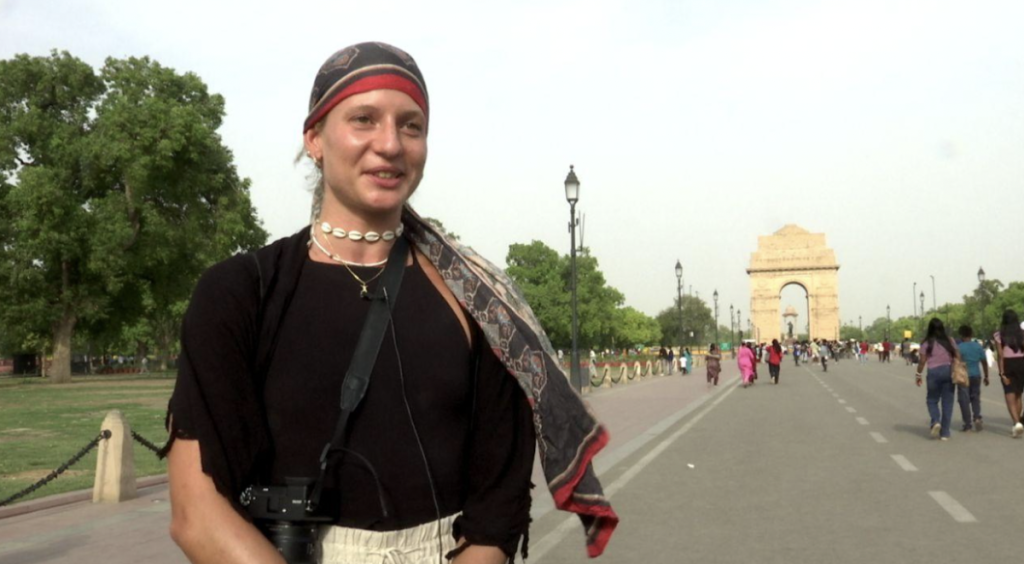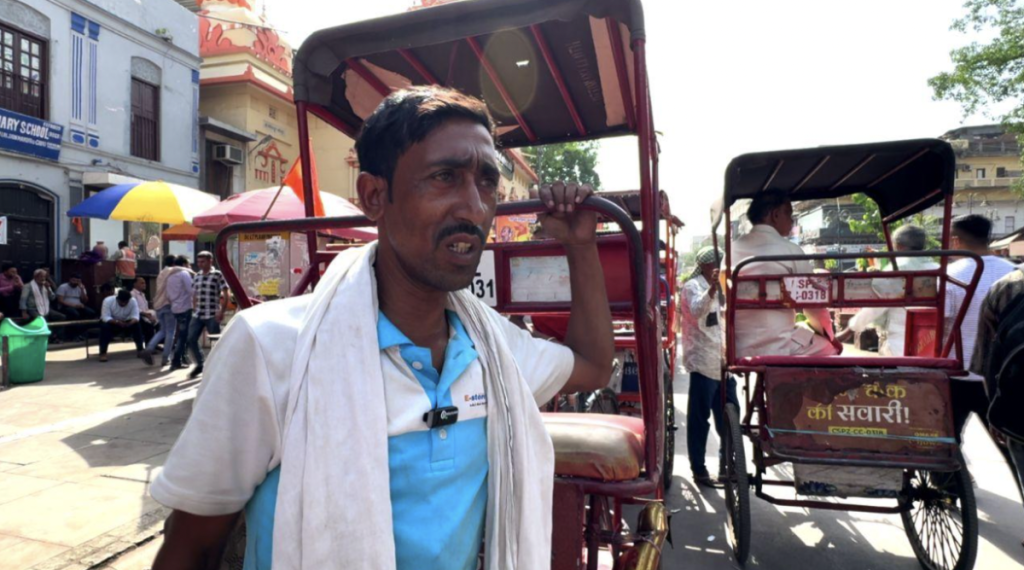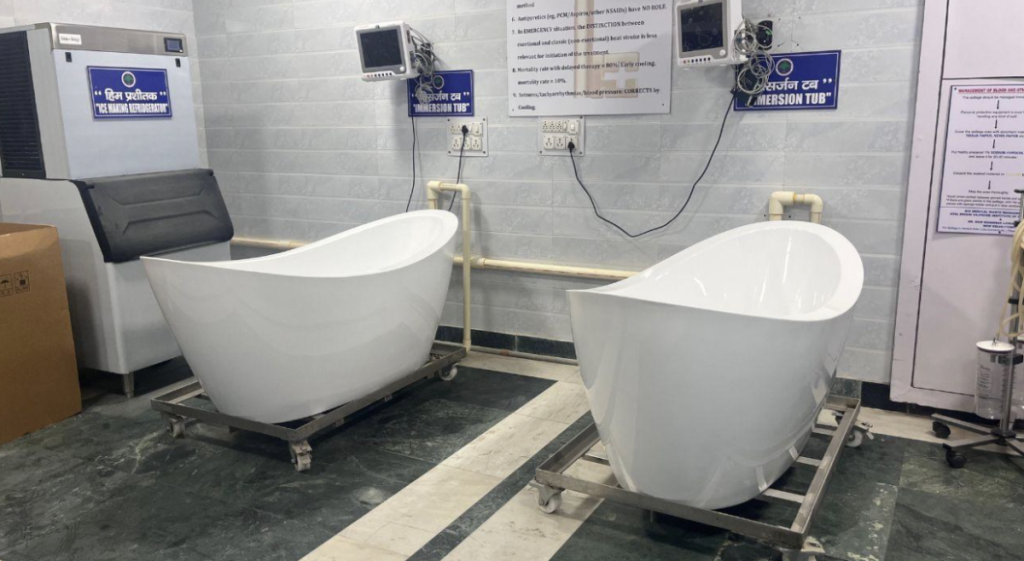As Delhi Courses Through Another Punishing Summer, Residents Are Once Again Pushed to the Brink
Delhi, the bustling capital of India, is no stranger to sweltering summers, and the heatwaves that grip the city often pushes its residents and infrastructure to the brink. Temperatures often soar past 40° Celsius, leaving the city’s iconic landmarks, from the majestic India Gate to the vibrant lanes of Chandni Chowk, deserted.
The India Meteorological Department (IMD) issued a heatwave warning for Delhi NCR on May 11 stating that the temperature is likely to rise after a few days of rainfall. The IMD also forecast that the maximum temperature in Delhi is likely to cross 40°C.
In April, the IMD had issued heatwave warnings for Delhi thrice, covering a total of nine days. Temperatures during these periods reached 40°C to 42°C, driven by dry westerly winds and clear skies, with the city experiencing its first heatwave on April 7. These alerts underscored the early onset of extreme heat, briefly interrupted by a western disturbance around April 10, before conditions worsened again mid-month.
“We are expecting the temperature to be between 39°C to 41°C,” Dr. Naresh Kumar, a scientist at IMD, had said on May 11.
For the capital’s 33 million residents, this heatwave is not just a seasonal inconvenience. It’s a public health crisis, an economic strain, and a stark reminder of the city’s vulnerabilities to climate change. As hospitals report a surge in heatstroke cases, street vendors toil under the unrelenting sun, and parents grapple with scorching school schedules.
Kartavya Path, the ceremonial boulevard leading to Rashtrapati Bhavan, is usually full with tourists and vendors. Now, only a handful of visitors brave the midday sun, clutching water bottles and shielding themselves with umbrellas. The heat radiates off the asphalt, creating mirages that distort the view of India Gate in the distance. For those who must venture out, the conditions are punishing. Sweat-soaked clothes and parched throats are common, and the elderly and children are particularly vulnerable.
“It is really hotter here. So much hotter than in my home country. But, to be honest, I expected it to be more uncomfortable as it is. There are not many tourists here right now,” said Carolina, a tourist from Slovakia.

Carolina, a tourist from Slovakia. Photo: Syed Abubakr.
In the historic lanes of Chandni Chowk, one of Delhi’s oldest markets, the heatwave has not deterred the spirit of survival. Vendors and rickshaw pullers, their faces glistening with sweat, fan themselves with makeshift cardboard fans while trying to attract customers. The market, known for its chaotic energy, is quieter than usual, with many shoppers opting to stay home. For these daily wagers, however, staying home is not an option. Their livelihoods depend on daily earnings, and the heat, no matter how oppressive, cannot stop them from setting up their stalls, and pull the rickshaw. Many cover their heads with damp clothes, but the physical toll is evident in their weary expressions.
“There is so much heat. I get thirsty after a bit when I pull my rickshaw with passengers sitting in it. I step off to drink water. Without that, I can’t pull the passenger,” says Mohammad Aftab.

Aftab, a rickshaw puller at Chandni Chowk. Photo: Syed Abubakr.
The heatwave’s impact extends beyond the streets to the city’s schools, where parents face the challenge of protecting their children from the midday sun. With schools maintaining regular schedules, children are released at noon, when temperatures peak. Outside Lady Irwin Senior Secondary School in Defence Colony, parents wait anxiously under the sparse shade of trees, fanning themselves with newspapers. The children emerge from the school gates looking exhausted, their uniforms damp with sweat.
“We are seeing a sudden rise in temperatures. When I come to pick my child from school at noon, there is so much heat outside. I feel the heatwave on road. Large number of vehicles on Delhi roads is one of the reasons behind this. Our kids face trouble and so do we.” says Puri, a parent whose girl child studies in the school.
Hospital woes
The crisis is not merely a matter of discomfort, often it’s a matter of life and death. Delhi’s hospitals are grappling with a surge in heatstroke cases, a grim echo of last year’s deadly heatwave. The city reportedly recorded a staggering 80 heat-related deaths, with Safdarjung Hospital alone reporting 33 fatalities, the highest among Delhi’s medical facilities.
Other hospitals, including Lok Nayak Hospital, Ram Manohar Lohia Hospital, Lady Hardinge Medical College and Deen Dayal Upadhyay Hospital, also recorded multiple fatalities, particularly in the month of June. Last year, the heatwave saw over 40,000 suspected heatstroke cases nationwide. These numbers, experts warn, are likely underreported due to inconsistent data collection and the difficulty of attributing deaths to heat-related causes.
Safdarjung, one of Delhi’s largest public healthcare facilities, has been at the epicentre of the heatwave response. Despite the highest toll last year, it has yet to establish a dedicated heatwave unit, a critical gap in its preparedness. The lack of a specialised unit means that heatstroke patients are often treated alongside other emergencies, potentially delaying critical care. This gap in facilities means patients are often referred to better-equipped hospitals like RML.
We tried reaching out to the medical superintendent of Safdarjung Hospital, Dr. Sandeep Bansal, and its media spokesperson Poonam Dhanda to get their response on the preparedness of the hospital to tackle heatwave-affected patients. Despite multiple requests, they refused to comment.
Dr Ram Manohar Lohia Hospital, which had set up a dedicated heat stroke unit last year, has reactivated the facility in anticipation of rising admissions. RML’s medical superintendent Dr. Ajay Shukla said that heat stroke is becoming increasingly common in Delhi, and immediate intervention is crucial to avoid organ failure or death.
“Our heatstroke unit is based on the latest immersion cooling technology. Mortality rate in heatstroke affected patients is very high, almost as high as 80%,” Shukla said.

Inside the dedicated heatstroke unit at RML Hospital. Photo: Sumit Singh.
The hospital has restarted a special ward within its emergency department, equipped with two large tubs filled with 50 kilograms of ice each. Patients with severe heatstroke will be immersed in these tubs to quickly lower their body temperature, a vital measure to avert life-threatening complications.
The Union health ministry has issued guidelines to address the crisis, including the 2021 National Action Plan on Heat-related Illnesses and 2024 protocols for emergency cooling and autopsy findings. However, a 2024 report by HeatWatch, titled Struck by Heat: A News Analysis of Heatstroke Deaths in India in 2024, noted that many healthcare professionals remain unaware of these guidelines, and hospital infrastructure is often ill-equipped to handle the rising tide of heatstroke cases. The report emphasised the absence of a transparent, publicly accessible system to track heatwave deaths, which contributes to underreporting and hampers effective response planning. These systemic gaps have left Delhi’s healthcare system playing catch-up, even as the city faces another heatwave.
Experts warn of a grim future
Beyond the immediate health crisis, environmentalists argue that Delhi’s heatwave is a symptom of deeper, structural issues. Bhavreen Kandhari, a prominent environmental activist based in Delhi, points to poor urban planning and unchecked construction as key contributors to the city’s vulnerability. Over the decades, Delhi has lost significant green cover to concrete jungles, creating urban heat islands that trap heat and exacerbate temperatures. The city’s once-abundant trees have been replaced by high-rise buildings and sprawling roads, leaving little respite from the sun. Kandhari warns that climate change is accelerating these trends, and without urgent action, Delhi’s heatwaves will only grow more severe.
“Urban heat island is a term used to refer to the way heat is captured. The city becomes a capture zone for the heat because of excessive concretisation that is happening. In Delhi, the Urban Heat Island effect causes urban areas to be significantly warmer than surrounding rural regions, driven by rapid urbanisation, extensive concrete, loss of green cover, vehicular and industrial emissions, and air pollution. This phenomenon, intensified by tall buildings and poor ventilation, creates heat-trapping hotspots, exacerbating heatwaves and health risks,” says Bhavreen Kandhari.
The Delhi government and the Union environment ministry claim to be taking note of the crisis. Urban greening projects, emission control measures, and long-term climate adaptation plans are in the works, but progress is slow.
The immediate reality is one of survival – finding shade, securing water, and avoiding the midday sun. Street vendors like those in Chandni Chowk, who cannot afford to stop working, and homeless individuals, who lack access to shelter, are particularly vulnerable.
As Delhi endures another sweltering day, the message from experts is clear: the heatwave is not an isolated event but a harbinger of a warming future. The city’s hospitals, already stretched thin, must prioritise specialised heatwave units and better staff training. Urban planners must rethink Delhi’s concrete-heavy landscape, restoring green spaces and implementing heat-resilient infrastructure.
Public fountains, where children gulp water greedily, and puddles, where birds splash to cool off, offer fleeting moments of relief. But these small reprieves cannot mask the larger challenge. Delhi’s heatwave is a call to action – a reminder that without bold, collective efforts, the city’s summers will only grow hotter and deadlier.
Syed Abubakr, Shoaibur Rahman and Arijit Gupta contributed to this report.
The writers are freelance journalists based in New Delhi.
This article went live on May twentieth, two thousand twenty five, at zero minutes past four in the afternoon.The Wire is now on WhatsApp. Follow our channel for sharp analysis and opinions on the latest developments.




